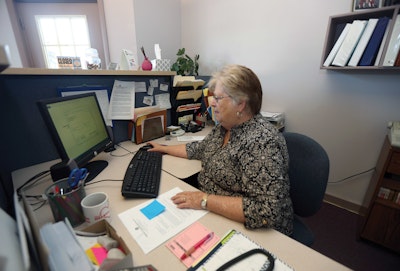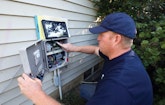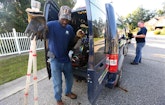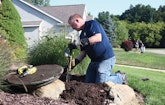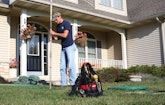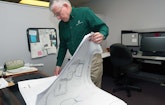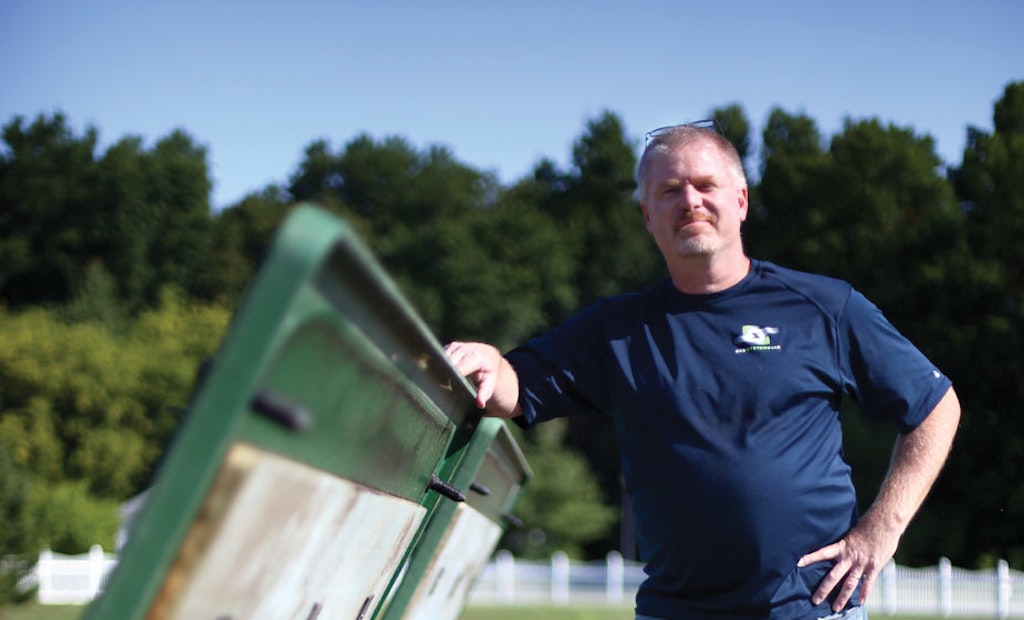
Mike Stephens inspects an Orenco Systems AX100 unit at the River Rock Landing community wastewater treatment facility.
Mike Stephens joined his father’s onsite system engineering firm in 1998 as business manager and field technician, and soon afterward it became apparent that maintenance was going to play an important role in the business. That realization led father Larry Stephens, P.E., and Mike to form a companion operation, SCS Systems, to care for a wide variety of residential and community wastewater systems.
It proved to be a sound strategic move, as demand for operations and maintenance assistance has grown continually over the years. System engineering was the backbone of the business when Onsite Installer profiled Larry and design company Stephens Consulting Services a decade ago. Since then, Mike’s service side of the business has taken off while Larry continues to lend his design expertise to clients covering a large area in Lower Michigan.
“State regulations required operation and maintenance on sand filters, so we trained contractors how to install and maintain them,” Mike Stephens says. “However, it wasn’t profitable for contractors to have a backhoe sitting idle or to pull a heavy-equipment operator off a job to answer alarm calls.”
The younger Stephens threw himself into filling the void. Today, SCS Systems has signed contracts for 105 individual residential systems, 28 community systems serving more than 490 single-family homes, eight mobile home parks, and 19 commercial systems. Community systems with STEP or STEG collection account for an additional 300 individual on-lot tanks and pumping systems.
“We’re unique because we’re one of very few companies in the state to service single-family and community wastewater systems,” says Stephens, 47. “In 2016, community and cluster systems were 52 percent of our income, mobile home parks were 7 percent, and commercial were 20 percent.” The remainder, or 21 percent, were single-family homes.
KEEPING BUSY
Initially, there weren’t enough maintenance contracts to fill 40-hour weeks. Maintenance was annual and included cleaning effluent filters, measuring sludge and scum layers, inspecting alternating valves (K-Rain), flushing laterals, and providing comprehensive operational reports to homeowners and regulatory agencies.
Stephens used spare time to earn his Class SC (special classification for recirculating sand filters), Class L1 and L2 (stabilization and aerated lagoons), and Class D (small municipal wastewater treatment plant operator) certifications. He also computerized the accounting system for both companies.
Stephens performed surveying and construction staking and inspecting single-family, engineered onsite systems during installation to ensure they were design-compliant.
For nine years, Stephens worked alone or with summer help. “I was on Dad’s company payroll until 2006 when I drew my first paycheck from SCS Systems,” he recalls. Both companies share the same building, and father and son work in adjoining cubicles.
By 2009, Mike Stephens had more work than he could handle, but not enough to afford a full-time employee. Gambling that more contracts would come, he hired Matt Sawyer. Today, Sawyer holds Class SC, Class L1, and Class L2 certifications.
A year later, Stephens’ “grow or go home” attitude led to purchasing the service contracts of Sierra Consultants, a consulting and operations company in Grand Rapids. The contracts included community and commercial systems and mobile home parks. “We’d been struggling to establish a presence in the Grand Rapids area, but now the door to the west side of the state was open, the explosion in growth was substantial,” Stephens says.
In 2017, inspections, troubleshooting, and maintenance accounted for 94 percent the workload, while repairing or replacing components was 6 percent. Stephens and three full-time technicians maintained 28 community/cluster systems and a combined 45 service contracts for AdvanTex (Orenco Systems) and Norweco advanced treatment units. Ben Bogner joined the crew in 2014, and Tommie Johnson arrived in February 2017. Mike Stephens’ mother, Berneda Stephens, and his wife, Marsha Roudabush, provide office and bookkeeping support.
“Our contract renewal rate is 96 percent,” Mike Stephens says. “Some clients have been with us for more than 20 years. Contracts we lose are usually due to new management preferring the lowest bidder over the proven provider.”
WINDSHIELD TIME
The expansion emphasized the importance of routing to maximize mileage and travel time — it’s 75 miles to Grand Rapids — and to ensure everyone is home nightly and over weekends. “We spend three to four days a month in the Grand Rapids area, hitting five or six projects per day,” Stephens says. “Depending on the systems, maintenance takes 30 to 60 minutes, often with a crew of two tackling different tasks simultaneously. It’s a highly productive strategy, especially for safety assurance and maintaining complex components.”
The company owns two 2010 Ford Transit Connect cargo vans. One van has shelving and storage for repair parts and tools, such as a Hach HQ40d dissolved oxygen/pH meter, Honda gas-powered 35 gpm suction pump, and various Ryobi 18-volt cordless power tools. The other van is open to transport larger equipment and parts. “Our goal is to repair the problem in one visit, thereby reducing our overhead and homeowner expenses,” Stephens says. The vans cover 32,000 miles annually and get 22 to 26 mpg fully loaded.
Within two weeks of spending $800 to have vinyl graphics added to the vehicles, Stephens heard from a homeowner with a pump problem. “He was 70 miles away and driving behind one of our vans,” he explains. “The labor-intensive repair paid for the lettering and graphics.”
Most community systems are inspected monthly, quarterly, or biannually depending on equipment, permit requirements, risk, and build-out rates. Typical inspections include calculating flow and verifying pump and control operations. Technicians check tank water levels and inspect pumps, filters, valves, audiovisual alarms and observation ports. Periodically they measure sludge and scum levels, amp draws and pump drawdown rates.
The visits generate so much paperwork it’s become problematic. Technicians use more than three dozen specific forms to cover different system configurations and equipment. In 2017, Stephens purchased RealTime Forms and helped Famhost Apps customize the software.
Maintenance reports are one of the only tangible items technicians give most homeowners. “They must be comprehensive, accurate, informative and meet regulatory requirements,” Stephens says. “Reports also must be easy for my guys to complete via check boxes, drop-down menus and self-populating common fields. For example, one mouse click inserts sentences such as: ‘Septic tank doesn’t need to be pumped this year.’”
INDUSTRY COOPERATION
Managing the large-scale and commercial systems designed by his father seldom raises Stephens’ eyebrows. The challenge is managing complex systems designed by other engineers and using different equipment. The latest example was taking over a constructed wetland serving a motel. “It’s been a learning curve,” he says. “Dawn Rheinhold, the wetland specialist at Michigan State University, was a primary source of information, as they have a constructed wetland on campus.”
The Michigan Department of Environmental Quality had cited the motel owner for wetland neglect and failure to file O&M reports for 20 years. “We cut and tamed a 10-foot-tall jungle of unwanted vegetation and trees growing in the cells,” he says. “The system, designed to treat 15,000 gpd, averages 2,000 to 4,000 gpd, so it still produces high-quality effluent.”
Recently, the state Department of Transportation asked Stephens to evaluate five of its 53 rest areas with onsite systems. “They want a maintenance program for them, but accepting the work would seriously stretch our resources,” he says. “Some locations are 4 1/2 hours from the office.”
Because SCS Systems covers many geographical areas, Stephens relies on a network of contractors for excavating repairs or pumping, and to offer as references. “The list is short, and we’re very selective,” he says. “There are five names or less in our highly recommended column. Adding the contractors with whom we’ve worked might push it up to 12 names.”
TROUBLESHOOTING GURU
Of course, Dad remains his favorite partner. Although Larry, 72, has downsized Stephens Consulting Services since 2007 and now works alone, designing fewer than 20 projects per year, he remains his son’s primary consultant. “When we can’t figure out why large commercial and community systems have unexpected treatment levels, Dad will find the answer,” Mike says.
For example, technicians were finding septic tank effluent samples in larger systems, especially those with grinder pumps ahead of the tanks, to indicate higher-strength wastewater than expected. Previously, engineers assumed three-day retention times would produce similar strength effluent whether systems had one large community tank or a smaller tank at each home.
“Instead, sampling indicated that effluent from large community tanks was often two to three times the strength of individual septic tank effluent,” Mike says. “Effluent screens maintain the solids content at normal or below normal, but they won’t remove soluble BOD.” This discovery led Larry to place more emphasis on designing systems for organic loading, not just hydraulic loading.
The elder Stephens improved results in some existing systems by adding aeration to the tanks, thus generating biological growth and reducing BOD levels. However, unexpected repairs and replacements strain homeowners’ limited financial resources, occasionally causing father and son to be a bit innovative in their problem-solving.
For example, when a subdivision on advanced treatment units connected to the newly available municipal sewer, Mike salvaged the valuable equipment for nonprofit clients and low-income families. “The units are so robust that it’s a shame to see them in landfills when they still have usable life,” he says.
Phone “alarm triage” is another way the company helps customers save money. By talking homeowners through several steps at the control panel, Mike has identified the reason for the alarm without visiting the site. “Several owners were so happy to save the cost of a service call that they offered to pay for my time on the phone with them,” he says.
GOING STRONG
Larry Stephens’ reputation continues to attract major projects. “We seem to get some of the most difficult problems, but if they were all easy, everyone would be doing it,” he says. Stephens recently designed the largest community system of his career — a 100,000 gpd facility for a seasonal resort. Then the client asked him to upgrade the design to treat 350,000 gpd. Another client hired him to design a 30,000 gpd replacement system for a mobile home park in Ohio, so he registered as a licensed engineer in that state.
Mike Stephens’ goal is to make SCS Systems an enjoyable place to work, with incomes capable of supporting workers’ families and retirement plans. He never wants to grow so big that employees lose their personal time. As for Larry working in the cubicle next door, he’s contented to continue to share expertise in system design.
“Dad has no plans to go anywhere soon,” Mike says. “He finds pleasure in the work and enjoys speaking at conferences and other venues to share his knowledge.”
Best of the best
Mike Stephens doesn’t look for wastewater industry experience when hiring workers for SCS Systems. “My best hires are individuals with a strong work ethic, personable and willing to learn,” he says. “I can teach the core job, but I rarely can teach someone how to put in an honest day’s work or to engage confidently with customers.”
New employees spend three to five years learning the daily routines. About 30 percent of the learning curve is staying current with changes in technology or best practices, and overcoming surprises in the field.
Stephens holds his subcontractors to the same rigorous standards. He says they all possess identical characteristics to ensure total customer satisfaction and loyalty. “They understand the value of relationships and always show their professionalism by wearing clean clothes, being neatly groomed, and taking time to educate clients,” he says.
He further stresses promptness, saying his workers and subcontractors often arrive five minutes before scheduled appointments. They make an effort to learn about and understand each engineered system they service. “We take every opportunity at wastewater conferences to find such contractors working in our geographical areas,” Stephens says. “They are the people we subcontract for tank pumping and excavating repairs, or recommending to our clients.”

